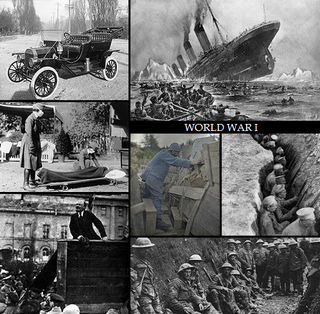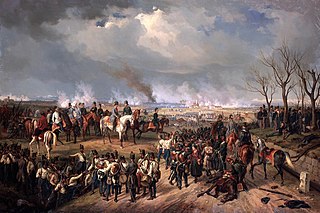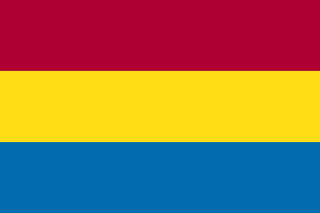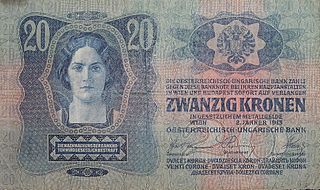| |||||
| Decades: | |||||
|---|---|---|---|---|---|
| See also: | |||||
The following lists events that happened during 1910 in the Austro-Hungarian Empire .
| |||||
| Decades: | |||||
|---|---|---|---|---|---|
| See also: | |||||
The following lists events that happened during 1910 in the Austro-Hungarian Empire .

Austria-Hungary, often referred to as the Austro-Hungarian Empire or the Dual Monarchy, was a constitutional monarchy and multinational state in Central Europe between 1867 and 1918. Austria-Hungary was a military and diplomatic alliance of two sovereign states, with a single monarch who was titled both Emperor of Austria and King of Hungary. Austria-Hungary constituted the last phase in the constitutional evolution of the Habsburg monarchy: it was formed with the Austro-Hungarian Compromise of 1867 in the aftermath of the Austro-Prussian War and was dissolved shortly after Hungary terminated the union with Austria on 31 October 1918.

The 1910s was a decade that began on January 1, 1910, and ended on December 31, 1919.
1910 (MCMX) was a common year starting on Saturday of the Gregorian calendar and a common year starting on Friday of the Julian calendar, the 1910th year of the Common Era (CE) and Anno Domini (AD) designations, the 910th year of the 2nd millennium, the 10th year of the 20th century, and the 1st year of the 1910s decade. As of the start of 1910, the Gregorian calendar was 13 days ahead of the Julian calendar, which remained in localized use until 1923.

1849 (MDCCCXLIX) was a common year starting on Monday of the Gregorian calendar and a common year starting on Saturday of the Julian calendar, the 1849th year of the Common Era (CE) and Anno Domini (AD) designations, the 849th year of the 2nd millennium, the 49th year of the 19th century, and the 10th and last year of the 1840s decade. As of the start of 1849, the Gregorian calendar was 12 days ahead of the Julian calendar, which remained in localized use until 1923.

Franz Joseph I or Francis Joseph I was Emperor of Austria, King of Hungary, and the ruler of the other states of the Habsburg monarchy from 2 December 1848 until his death on 21 November 1916. In the early part of his reign, his realms and territories were referred to as the Austrian Empire, but were reconstituted as the dual monarchy of the Austro-Hungarian Empire in 1867. From 1 May 1850 to 24 August 1866, he was also president of the German Confederation.

Burgenland is the easternmost and least populous province of Austria. It consists of two statutory cities and seven rural districts, with a total of 171 municipalities. It is 166 km (103 mi) long from north to south but much narrower from west to east. The region is part of the Centrope Project.

Sopron (Hungarian pronunciation: [ˈʃopron]; German: Ödenburg, German pronunciation: [ˈøːdn̩ˌbʊʁk] is a city in Hungary on the Austrian border, near Lake Neusiedl/Lake Fertő.

Rudolf Maister was a Slovene military officer, poet and political activist. The soldiers who fought under Maister's command in northern Slovenia became known as "Maister's fighters". Maister was also an accomplished poet and self-taught painter.

The Triple Alliance was a military alliance between Germany, Austria-Hungary, and Italy. It was formed on 20 May 1882 and renewed periodically until it expired in 1915 during World War I. Germany and Austria-Hungary had been closely allied since 1879. Italy was looking for support against France shortly after it lost North African ambitions to the French. Each member promised mutual support in the event of an attack by any other great power. The treaty provided that Germany and Austria-Hungary were to assist Italy if it was attacked by France without provocation. In turn, Italy would assist Germany if attacked by France. In the event of a war between Austria-Hungary and Russia, Italy promised to remain neutral. The existence and membership of the treaty were well known, but its exact provisions were kept secret until 1919.

Galicia is a historical and geographic region spanning what is now southeastern Poland and western Ukraine, long part of the Polish–Lithuanian Commonwealth. It covers much of the other historic regions of Red Ruthenia and Lesser Poland.

The Tegetthoff class was a class of four dreadnought battleships built for the Austro-Hungarian Navy. Named for Austrian Admiral Wilhelm von Tegetthoff, the class was composed of SMS Viribus Unitis, SMS Tegetthoff, SMS Prinz Eugen, and SMS Szent István. Construction started on the ships shortly before World War I; Viribus Unitis and Tegetthoff were both laid down in 1910, Prinz Eugen and Szent István followed in 1912. Three of the four warships were built in the Stabilimento Tecnico Triestino shipyard in Trieste; Szent István was built in the Ganz-Danubius shipyard in Fiume, so that both parts of the Dual Monarchy would participate in the construction of the ships. The Tegetthoff-class ships hold the distinction for being the first and only dreadnought battleships of the Austro-Hungarian Navy. The SMS Szent István had a different more modern propulsion system than her sister ships.

The Austrian Littoral was a crown land (Kronland) of the Austrian Empire, established in 1849. It consisted of three regions: the Margraviate of Istria, Gorizia and Gradisca, and the Imperial Free City of Trieste. Throughout history, the region has been contested frequently, with parts of it controlled at various times by the Republic of Venice, Austria-Hungary, Italy, and Yugoslavia among others.
The Černová massacre was a shooting that took place in Csernova, Kingdom of Hungary on 27 October 1907 in which 15 people were killed and many were wounded after gendarmes fired into a crowd of people gathering for the consecration of the local Catholic church. The shootings sparked protests in European and American press and turned the world's attention to the treatment of minorities in the Hungarian part of Austria-Hungary.

The assassination of Archduke Franz Ferdinand is considered one of the key events that led to World War I. Archduke Franz Ferdinand of Austria, heir presumptive to the Austro-Hungarian throne, and his wife, Sophie, Duchess of Hohenberg, were assassinated on 28 June 1914 by Bosnian Serb student Gavrilo Princip. They were shot at close range while being driven through Sarajevo, the provincial capital of Bosnia-Herzegovina, formally annexed by Austria-Hungary in 1908.

The Order of Saint Stephen was an order of chivalry founded in 1764 by Maria Theresa. In 1938, Miklós Horthy took the rights and activities of Grand Master as Regent of Hungary. The name of the Order changed to the Royal Hungarian Order of Saint Stephen. The Order was terminated at the time of the proclamation of the Second Hungarian Republic in 1946. It was recreated in 2011 as the Hungarian Order of Saint Stephen, and to this day remains the highest order in Hungary.

The U.S. Embassy in Austria is located in Vienna. Since 2022, the United States Ambassador to Austria is Victoria Reggie Kennedy. The Austrian Embassy in the U.S. is located in Washington, D.C. Since 2019, the Austrian Ambassador to the United States is Martin Weiss.

Rudolf Graf Montecuccoli degli Erri was chief of the Austro-Hungarian Navy from 1904 to 1913 and largely responsible for the modernization of the fleet before the First World War.

Corpus separatum, a Latin term meaning "separated body", refers to the status of the City of Fiume while given a special legal and political status different from its environment under the rule of the Kingdom of Hungary. Formally known as City of Fiume and its District, it was instituted by Empress Maria Theresa in 1779, determining the semi-autonomous status of Fiume within the Habsburg monarchy until the fall of the Austro-Hungarian Empire in 1918.

The following events occurred in August 1910:

The economy of Austria-Hungary changed slowly during the existence of the Dual Monarchy, 1867-1918. The capitalist way of production spread throughout the Empire during its 50-year existence replacing medieval institutions. In 1873, the old capital Buda and Óbuda merged with the third city, Pest, thus creating the new metropolis of Budapest. The dynamic Pest grew into Hungary's administrative, political, economic, trade and cultural hub. Many of the state institutions and the modern administrative system of Hungary were established during this period. It was a large, heavily rural country with wealth and income levels a bit below the European average. Growth rates were similar to Europe as a whole. After 1895. migration became a major factor, with most headed to the United States.